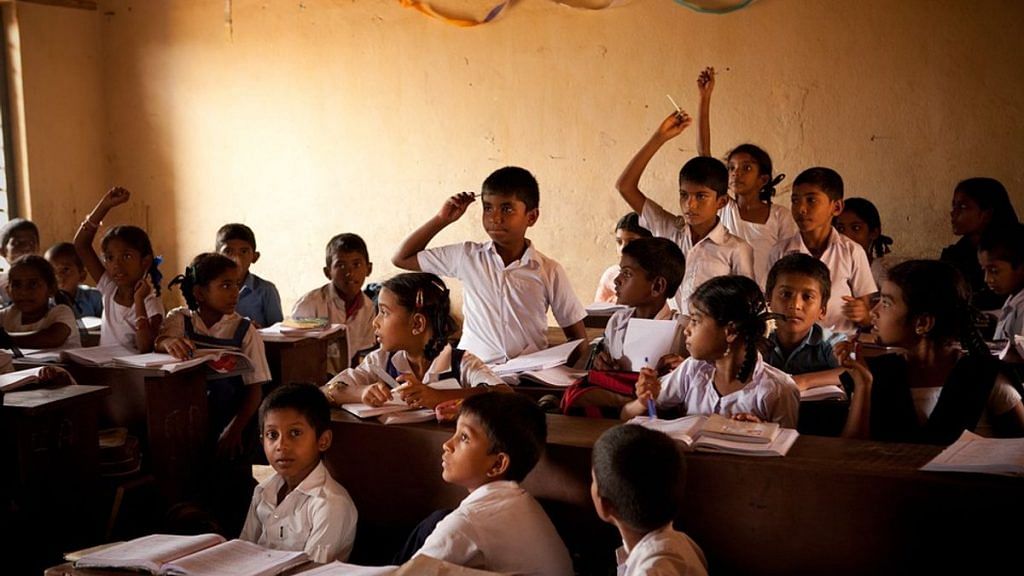New Delhi: The Narendra Modi government announced the new National Education Policy (NEP) Wednesday, bringing about sweeping changes in the Indian education system, both at the school and college level.
The policy also mentions the three-language formula where it says that of the three languages, two must be Indian languages, with English not to be considered as one. It also says that the freedom to choose the two Indian languages should be left to the states, regions or students.
The new NEP further advises the use of either the mother tongue, regional language or local language as the medium of instruction, at least until Class 5.
When the draft of the policy was released in June last year, there was much furore regarding changes in the three-language formula by Tamil Nadu and Karnataka as they made Hindi mandatory for school students in non-Hindi-speaking states as well.
ThePrint looks into why this formula has been a bone of contention between southern states and the Centre, its origin and controversies.
Also read: Sanskrit a casualty of 3-language formula, make it compulsory till Class 8: RSS-affiliate
Lack of uniformity in its implementation
The three-language formula was first devised by the central government in 1968 and incorporated in the National Education Policy. The idea behind the scheme was to ensure that students learnt more languages.
After 1968, it was only in 1992 that the policy was modified.
The formula was implemented across the country in 1968, barring Tamil Nadu that adopted a two-language policy.
When first implemented by the Indira Gandhi government in 1968, the formula stipulated that students from the Hindi-speaking states should take up English, Hindi and a modern Indian language, while students from non-Hindi speaking states should also take up Hindi, English and one Indian language.
However, its implementation was not uniform across the country.
A paper by Leena Ratti from the Central Institute of Education in Delhi University said: “In many of the Hindi-speaking states, Sanskrit became the third language instead of any modern Indian language (preferably south Indian language), whereas the non-Hindi speaking state such as Tamil Nadu operates through a two-language formula.”
“Some boards/institutions permit even European/foreign languages like Spanish, French and German in place of Hindi or Sanskrit. Only some states accepted the three-language formula in principle, while others made some adjustments and some changed to an extent that it became impossible to implement it,” according to the paper.
Controversy about the formula
Since 1937, Tamil Nadu has consistently opposed the decision to make Hindi compulsory in schools. The founder of Dravidar Kazhagam, Periyar E.V. Ramasamy was against then Madras chief minister C. Rajagopalachari’s decision to make Hindi mandatory.
The controversial provision in the draft NEP released last year said that students in the non-Hindi speaking states should take up Hindi, apart from English and a regional language as part of the three-language formula. One of the three languages could be changed in Class 6, the draft NEP had said.
The draft received backlash from almost every Tamil Nadu political leader. DMK leader M.K. Stalin said the three-language formula propagated the use of Hindi from pre-school to Class 12 and it was a big shocker, which could potentially divide the country.
There was furore in Karnataka too, with Congress leader and former chief minister, Siddaramaiah saying the draft was a brutal assault on the states.
“Nothing should be done against our opinion. There is no need for three languages. English and Kannada are there… they are enough. Kannada is our mother tongue, so primacy should be given to Kannada,” he had said.
After these controversies and opposition from southern states, the Modi government retracted the “mandatory-Hindi-lessons” clause from the draft.
The revised draft then said, “In keeping with the principle of flexibility, students who wish to change one or more of the three languages they are studying may do so in Grade 6 or Grade 7, so long as they are able to still demonstrate proficiency in three languages (one language at the literature level) in their modular Board Examinations some time during secondary school.”
Smriti Irani and German debate
The three-language formula hit the headlines in 2014 too when then HRD Minister Smriti Irani decided to remove German as a third language choice for students in Kendriya Vidyalayas (KVs).
Close to 80,000 students in KVs across the country from Classes 6-8 were studying German that time when the government dropped the language.
The move to remove German, thus, inevitably made Sanskrit a compulsory third language, which triggered debate.
At the time, Irani defended the move by saying that the earlier arrangement was in violation of the three-language formula in which the third language must be a modern Indian language or Sanskrit. She had said German would continue to be taught as an “additional subject of hobby class”.
Also read: Chetan Bhagat likes the three-language formula, Swara Bhasker says Article 15 ‘gives her hope’
